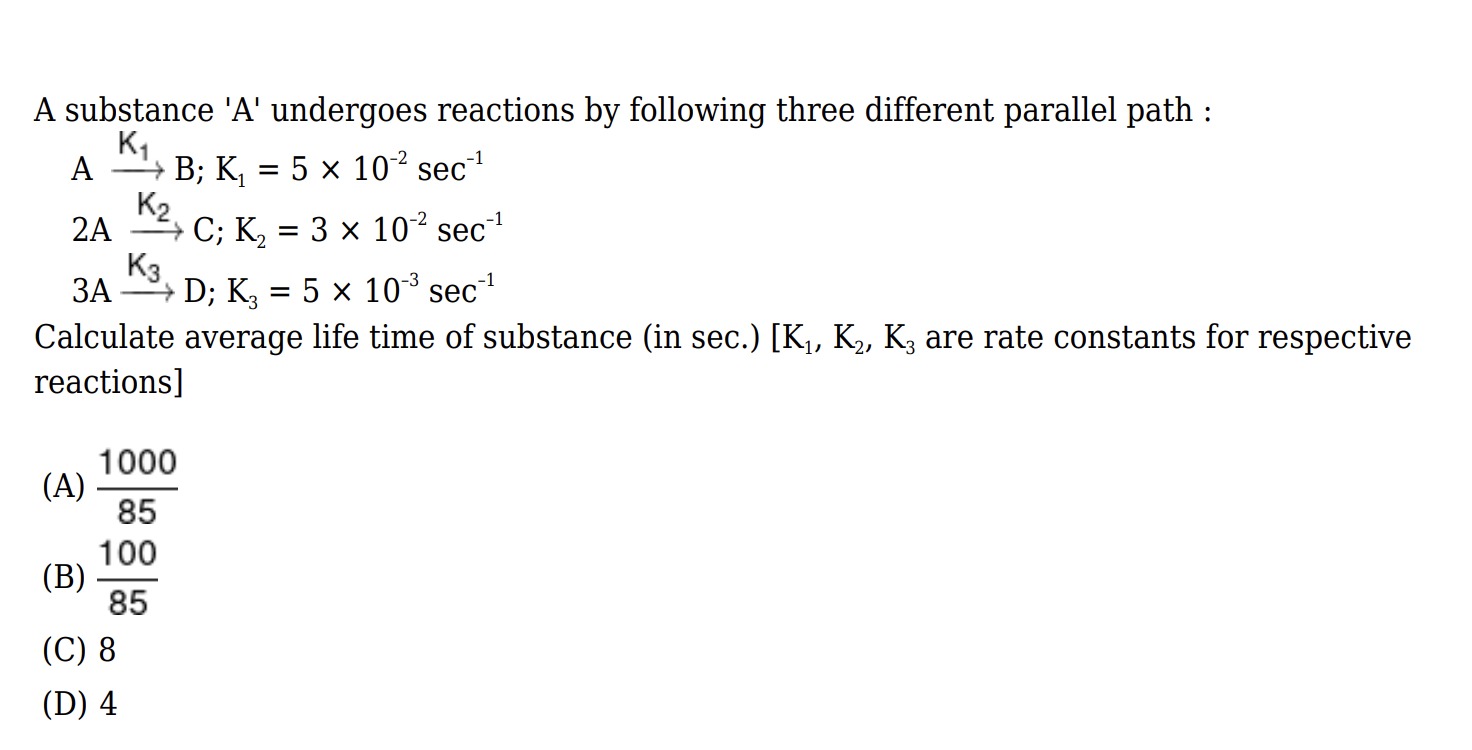Question
Question: A substance 'A' undergoes reactions by following three different parallel path : $A \xrightarrow{K_1...
A substance 'A' undergoes reactions by following three different parallel path : AK1B;K1=5×10−2sec−1
2AK2C;K2=3×10−2sec−1
3AK3D;K3=5×10−3sec−1
Calculate average life time of substance (in sec.) [K1,K2,K3 are rate constants for respective reactions]

851000
85100
8
4
851000
Solution
The substance 'A' undergoes three parallel reactions:
- AK1B with rate constant K1=5×10−2s−1
- 2AK2C with rate constant K2=3×10−2s−1
- 3AK3D with rate constant K3=5×10−3s−1
The units of the rate constants are given as s−1 for all three reactions. For a first-order reaction, the rate constant has units of s−1. For a second-order reaction, the rate constant has units of M−1s−1 (or concentration−1s−1). For a third-order reaction, the rate constant has units of M−2s−1 (or concentration−2s−1).
The fact that all given rate constants have the unit s−1, and the question asks for a single value of average lifetime (which for reactions other than first order depends on initial concentration), strongly suggests that all three parallel reactions are treated as first-order processes with respect to A, with the given rate constants. The stoichiometry given (2A→C and 3A→D) likely represents the overall stoichiometry but not the rate law order, or the reactions are pseudo-first-order under conditions not explicitly stated (e.g., excess of other reactants, which are not mentioned). Assuming the rate laws are first order in A with the given constants is the most consistent interpretation given the units and the nature of the options.
So, the rate of disappearance of A due to each reaction is assumed to be:
- Rate1=K1[A]
- Rate2=K2[A]
- Rate3=K3[A]
The total rate of disappearance of A is the sum of the rates of the parallel reactions: −dtd[A]=Rate1+Rate2+Rate3
−dtd[A]=K1[A]+K2[A]+K3[A]
−dtd[A]=(K1+K2+K3)[A]
This is a first-order rate law with an effective rate constant Keff=K1+K2+K3.
For a first-order reaction, the average lifetime (τ) is the reciprocal of the rate constant.
τ=Keff1
Substitute the given values of the rate constants:
K1=5×10−2s−1
K2=3×10−2s−1
K3=5×10−3s−1=0.5×10−2s−1
Keff=(5×10−2)+(3×10−2)+(0.5×10−2)s−1
Keff=(5+3+0.5)×10−2s−1
Keff=8.5×10−2s−1
Now calculate the average lifetime:
τ=8.5×10−21s
τ=8.5/1001s
τ=8.5100s
To remove the decimal, multiply the numerator and denominator by 10:
τ=851000s
